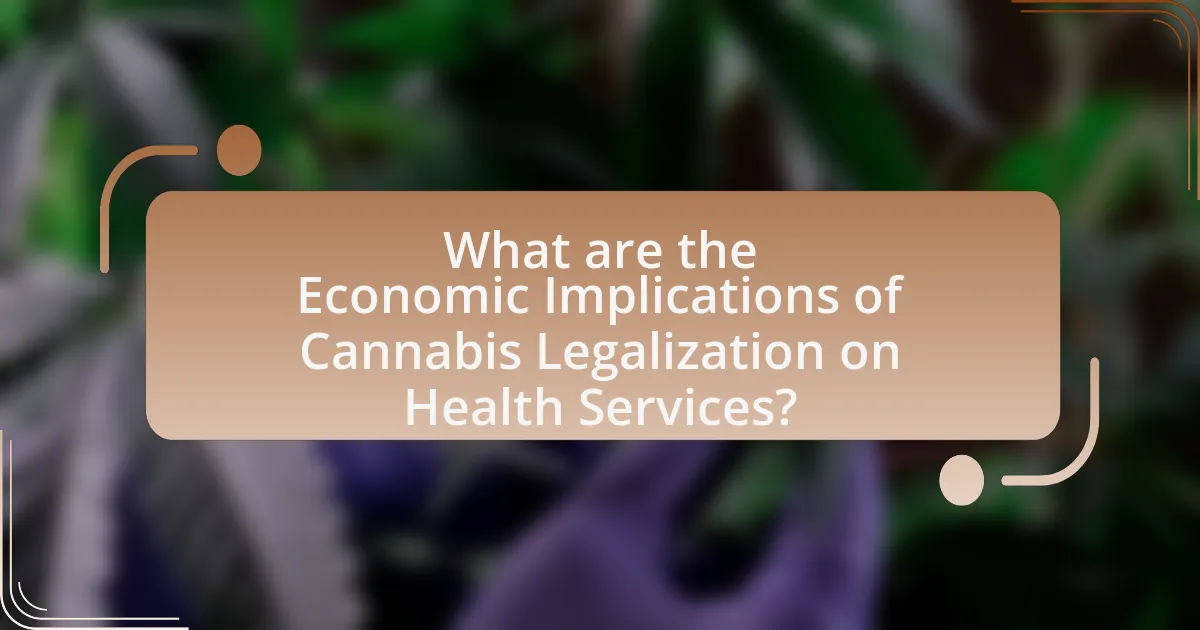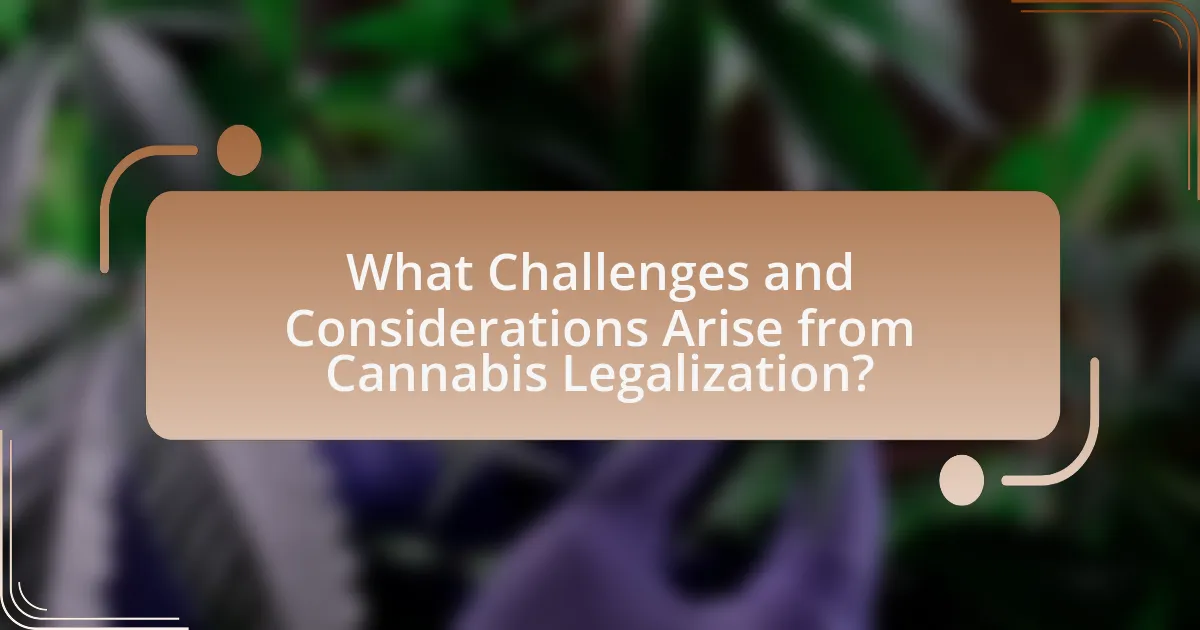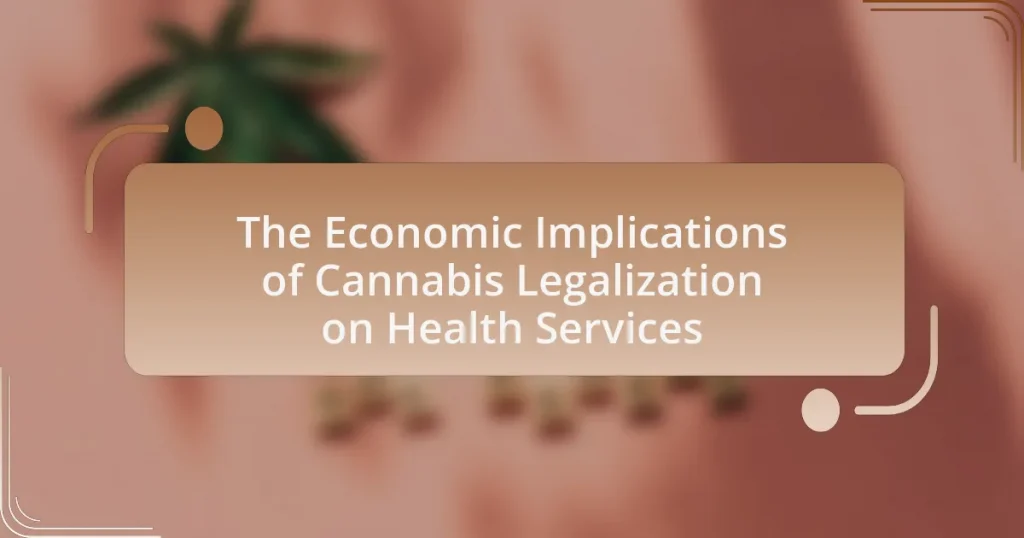The article examines the economic implications of cannabis legalization on health services, highlighting the potential for increased tax revenue, reduced law enforcement costs, and healthcare savings. It details how states like Colorado have benefited from significant tax income, which can be reinvested into public health initiatives and substance abuse programs. The article also discusses the impact of cannabis legalization on healthcare costs, including reductions in prescription drug expenditures and the potential for job creation within the health services sector. Additionally, it addresses the challenges and considerations that arise from legalization, such as regulatory issues and the need for effective patient education and safety protocols.

What are the Economic Implications of Cannabis Legalization on Health Services?
The economic implications of cannabis legalization on health services include increased tax revenue, reduced law enforcement costs, and potential healthcare savings. Legalization can generate significant tax revenue; for example, Colorado collected over $1.5 billion in cannabis tax revenue from 2014 to 2021, which can be reinvested into health services. Additionally, legalization reduces law enforcement expenditures related to cannabis prohibition, allowing funds to be redirected to healthcare initiatives. Furthermore, studies indicate that cannabis can serve as a substitute for more expensive pharmaceuticals, potentially lowering overall healthcare costs. For instance, a study published in the Journal of Health Economics found that states with legal medical cannabis saw a 15% reduction in prescription drug use among Medicare beneficiaries. These factors collectively illustrate the positive economic impact of cannabis legalization on health services.
How does cannabis legalization impact healthcare funding?
Cannabis legalization positively impacts healthcare funding by generating tax revenue that can be allocated to health services. For instance, states like Colorado have reported over $1 billion in tax revenue since legalization in 2014, with a significant portion directed towards public health initiatives and substance abuse programs. This financial influx allows for enhanced healthcare services, including mental health support and addiction treatment, thereby improving overall community health outcomes.
What are the potential revenue sources from cannabis taxation?
The potential revenue sources from cannabis taxation include sales taxes, excise taxes, and licensing fees. Sales taxes are applied to the retail price of cannabis products, generating significant revenue as consumer demand increases. Excise taxes, which are levied specifically on cannabis sales, can be set at varying rates depending on the product type, contributing additional funds to state and local budgets. Licensing fees are charged to businesses for the legal right to cultivate, distribute, or sell cannabis, providing another stream of revenue. For example, in Colorado, cannabis tax revenue reached over $387 million in 2020, demonstrating the financial impact of these taxation methods.
How can these revenues be allocated to health services?
Revenues from cannabis legalization can be allocated to health services by directing a percentage of tax revenue specifically towards public health initiatives, mental health programs, and substance abuse treatment. For instance, states like Colorado allocate a portion of their cannabis tax revenue—approximately 15%—to fund health-related programs, including mental health services and substance abuse prevention. This allocation not only enhances the capacity of health services but also addresses the potential public health impacts associated with increased cannabis use, thereby ensuring a comprehensive approach to health service funding.
What effects does cannabis legalization have on healthcare costs?
Cannabis legalization generally leads to a reduction in healthcare costs. Studies indicate that states with legalized cannabis have experienced lower prescription drug expenditures, particularly for pain management, as patients opt for cannabis instead of opioids. For instance, a study published in the Journal of Health Economics found that states with medical cannabis laws saw a 15% reduction in opioid prescriptions, which correlates with decreased healthcare spending related to opioid-related complications. Additionally, cannabis can serve as a treatment for various conditions, potentially lowering the overall burden on healthcare systems.
How might cannabis use influence prescription drug costs?
Cannabis use may reduce prescription drug costs by providing an alternative treatment option for various medical conditions. Studies indicate that patients using cannabis for pain management often report decreased reliance on opioid medications, which can be expensive and carry significant side effects. For instance, a study published in the Journal of Pain Research found that states with legal medical cannabis saw a 25% reduction in opioid prescriptions among Medicare beneficiaries. This shift can lead to lower overall healthcare costs associated with prescription drugs, as patients may substitute cannabis for more costly pharmaceuticals.
What are the potential savings in healthcare expenditures?
The potential savings in healthcare expenditures due to cannabis legalization can be significant, with estimates suggesting reductions of up to $1.3 billion annually in the United States. A study published in the journal Health Affairs indicated that states with legalized medical cannabis experienced a 15% decrease in opioid prescriptions, which correlates with lower healthcare costs associated with opioid-related treatments and complications. Additionally, cannabis use has been linked to reduced hospitalizations for certain conditions, further contributing to overall savings in healthcare expenditures.
How does cannabis legalization affect public health outcomes?
Cannabis legalization generally leads to mixed public health outcomes. Research indicates that legalization can reduce opioid-related deaths and hospitalizations, as seen in states like Colorado, where opioid overdose deaths decreased by 6.5% after legalization. Conversely, increased cannabis use can lead to higher rates of cannabis use disorder and potential mental health issues, particularly among adolescents. A study published in the Journal of the American Medical Association found that states with legalized cannabis reported a 20% increase in cannabis use among young adults. Thus, while cannabis legalization may alleviate some public health burdens, it also introduces new challenges that require ongoing monitoring and intervention.
What are the implications for mental health services?
The implications for mental health services following cannabis legalization include increased demand for mental health support and potential changes in treatment approaches. Research indicates that cannabis use can exacerbate mental health issues, such as anxiety and depression, leading to a higher need for therapeutic interventions. A study published in the Journal of Affective Disorders found that individuals with pre-existing mental health conditions may experience worsened symptoms with cannabis use, necessitating adjustments in mental health service delivery to address these challenges effectively. Additionally, mental health professionals may need to incorporate cannabis-related discussions into their practice, as patients increasingly seek guidance on its effects and potential therapeutic uses.
How does cannabis legalization impact substance abuse treatment programs?
Cannabis legalization generally leads to a reduction in substance abuse treatment program admissions for opioid use disorders. A study published in the Journal of Health Economics found that states with legalized cannabis experienced a 23% decrease in opioid-related treatment admissions, indicating that individuals may be substituting cannabis for more harmful substances. Additionally, the availability of legal cannabis can provide an alternative for patients seeking relief from chronic pain, potentially reducing reliance on prescription opioids. This shift in treatment dynamics suggests that cannabis legalization can positively influence the landscape of substance abuse treatment by offering safer alternatives and decreasing the burden on treatment facilities.

What are the Social and Economic Benefits of Cannabis Legalization?
Cannabis legalization provides significant social and economic benefits, including increased tax revenue, job creation, and reduced law enforcement costs. Legal markets for cannabis can generate substantial tax income; for example, Colorado collected over $1.7 billion in tax revenue from cannabis sales between 2014 and 2021. Additionally, the cannabis industry has created thousands of jobs, with estimates suggesting that legal cannabis could support over 1 million jobs in the U.S. by 2025. Furthermore, legalization reduces the burden on the criminal justice system, as law enforcement resources can be redirected from prosecuting cannabis-related offenses to addressing more serious crimes, leading to lower incarceration rates and associated costs.
How does cannabis legalization contribute to job creation in health services?
Cannabis legalization contributes to job creation in health services by expanding the demand for medical professionals and support staff involved in cannabis-related healthcare. As states legalize cannabis for medical use, healthcare providers require additional personnel, including doctors, nurses, pharmacists, and counselors, to manage patient care and educate them about cannabis therapies. For instance, a report from the National Cannabis Industry Association indicates that the cannabis industry has created over 300,000 jobs in the U.S., many of which are in health services, reflecting a significant growth in employment opportunities linked to cannabis legalization.
What types of jobs are created in the cannabis health sector?
The cannabis health sector creates a variety of jobs, including roles such as medical cannabis consultants, dispensary staff, researchers, and compliance officers. Medical cannabis consultants provide guidance to patients on appropriate cannabis use for health conditions, while dispensary staff manage retail operations and assist customers. Researchers conduct studies to explore the therapeutic benefits of cannabis, contributing to the growing body of evidence in the field. Compliance officers ensure that cannabis businesses adhere to regulations and standards, which is crucial in a heavily regulated industry. According to a report by Leafly, the cannabis industry employed over 300,000 people in the United States as of 2021, highlighting the sector’s significant job creation potential.
How does this job creation affect local economies?
Job creation from cannabis legalization positively affects local economies by increasing employment opportunities and stimulating economic growth. Specifically, the cannabis industry generates jobs in cultivation, distribution, retail, and ancillary services, leading to a reduction in local unemployment rates. For instance, a report by the Leafly Jobs Report in 2021 indicated that the cannabis industry created over 320,000 jobs in the United States, contributing significantly to local tax revenues. These increased revenues can be reinvested into community services, infrastructure, and public health initiatives, further enhancing the overall economic landscape.
What are the broader economic benefits of cannabis legalization?
Cannabis legalization provides significant broader economic benefits, including increased tax revenue, job creation, and reduced law enforcement costs. Legal markets for cannabis can generate substantial tax income; for instance, Colorado collected over $1.7 billion in cannabis tax revenue from 2014 to 2021, which has been allocated to education, healthcare, and infrastructure. Additionally, the cannabis industry has created thousands of jobs; in 2021, the sector employed over 400,000 people in the United States alone. Furthermore, legalization reduces law enforcement expenditures related to cannabis prohibition, allowing funds to be redirected to other public services. These factors collectively contribute to economic growth and stability in regions that adopt cannabis legalization.
How does cannabis legalization stimulate local businesses?
Cannabis legalization stimulates local businesses by creating new market opportunities and increasing consumer spending. When cannabis is legalized, it leads to the establishment of dispensaries, cultivation facilities, and ancillary businesses such as packaging and marketing services. For instance, in Colorado, cannabis sales generated over $2 billion in revenue in 2020, significantly benefiting local economies through job creation and tax revenue. This influx of business activity not only supports existing local enterprises but also attracts new investments, fostering a more vibrant economic environment.
What role does cannabis play in reducing illegal market activities?
Cannabis legalization plays a significant role in reducing illegal market activities by providing a regulated and legal framework for its sale and distribution. When cannabis is legalized, consumers are more likely to purchase it from licensed dispensaries rather than illegal sources, which diminishes the demand for black market products. For instance, a study by the Cato Institute found that states with legalized cannabis experienced a decrease in illegal sales, with some estimates suggesting a reduction of up to 50% in black market transactions. This shift not only curtails illegal activities but also generates tax revenue for governments, further incentivizing the transition from illegal to legal markets.

What Challenges and Considerations Arise from Cannabis Legalization?
Cannabis legalization presents several challenges and considerations, particularly regarding public health, regulatory frameworks, and economic impacts on health services. Public health concerns include potential increases in substance abuse, impaired driving incidents, and the need for effective education on responsible use. Regulatory frameworks must address quality control, taxation, and distribution, which can vary significantly between jurisdictions. Economically, while legalization can generate tax revenue and reduce law enforcement costs, it may also strain health services due to increased demand for treatment related to cannabis use and potential health complications. For instance, a study by the National Institute on Drug Abuse indicates that states with legalized cannabis have seen a rise in emergency room visits related to cannabis use, highlighting the need for adequate health service planning and resource allocation.
What regulatory challenges do health services face post-legalization?
Health services face significant regulatory challenges post-legalization of cannabis, primarily due to the need for compliance with varying state and federal laws. These challenges include navigating the discrepancies between state legalization and federal prohibition, which complicates funding, insurance coverage, and research opportunities. For instance, the federal classification of cannabis as a Schedule I substance restricts health services from accessing federal grants and limits the ability to conduct comprehensive clinical research, as highlighted by the National Academies of Sciences, Engineering, and Medicine in their 2017 report on cannabis. Additionally, health services must establish protocols for patient education, safety, and quality control, which are often not standardized across jurisdictions, leading to inconsistencies in patient care and potential legal liabilities.
How do varying state laws impact health service delivery?
Varying state laws significantly impact health service delivery by creating disparities in access, quality, and regulation of services. For instance, states that have legalized cannabis for medical or recreational use often see an increase in health service demand related to cannabis-related treatments, while states that maintain prohibition may limit patient access to alternative therapies. According to a study published in the Journal of Health Economics, states with legalized cannabis reported a 13% reduction in opioid prescriptions, indicating a shift in treatment approaches that can affect overall health service delivery. Additionally, differing regulations can lead to inconsistencies in provider training, patient education, and insurance coverage, further complicating the landscape of health services across state lines.
What are the implications for healthcare providers regarding cannabis use?
Healthcare providers face several implications regarding cannabis use, primarily related to patient care, legal considerations, and evolving treatment protocols. As cannabis becomes legalized in various jurisdictions, healthcare providers must navigate the complexities of prescribing it, including understanding its therapeutic benefits and potential risks. Research indicates that cannabis can be effective for conditions like chronic pain and epilepsy, necessitating providers to stay informed about dosing, administration routes, and patient education. Additionally, providers must consider the legal ramifications of cannabis use, including compliance with state laws and potential liability issues. A study published in the Journal of the American Medical Association highlights that healthcare providers who engage in open discussions about cannabis with patients can improve treatment outcomes and patient satisfaction. Thus, the implications for healthcare providers encompass the need for ongoing education, legal awareness, and a patient-centered approach to cannabis use in clinical practice.
How does cannabis legalization affect health service accessibility?
Cannabis legalization improves health service accessibility by increasing the availability of medical cannabis and reducing stigma associated with its use. Legalization allows patients to obtain cannabis through regulated dispensaries, ensuring product safety and quality. A study published in the Journal of Health Economics found that states with legalized medical cannabis saw a 25% reduction in opioid prescriptions, indicating that patients are accessing alternative treatments more readily. Furthermore, legalization often leads to increased funding for health services, as tax revenues from cannabis sales can be allocated to public health initiatives, enhancing overall healthcare access.
What barriers exist for patients seeking cannabis-related health services?
Barriers for patients seeking cannabis-related health services include legal restrictions, lack of insurance coverage, and limited access to knowledgeable healthcare providers. Legal restrictions vary by state, affecting patients’ ability to obtain cannabis legally; for instance, in some states, cannabis remains classified as a Schedule I substance, complicating access. Additionally, many insurance plans do not cover cannabis treatments, leading to out-of-pocket expenses that can deter patients. Furthermore, a shortage of healthcare providers who are informed about cannabis use and its therapeutic benefits limits patients’ ability to receive appropriate guidance and prescriptions. These factors collectively hinder patient access to cannabis-related health services.
How can health services improve access to cannabis treatments?
Health services can improve access to cannabis treatments by implementing comprehensive education programs for healthcare providers and patients. These programs can enhance understanding of cannabis benefits, dosing, and potential side effects, thereby increasing provider confidence in recommending cannabis as a treatment option. Research indicates that states with robust educational initiatives report higher rates of cannabis use for medical purposes, demonstrating a direct correlation between education and access. Additionally, health services can streamline the prescription process by integrating cannabis treatment options into electronic health records, making it easier for providers to prescribe and for patients to obtain necessary approvals. This approach has been shown to reduce barriers and increase patient engagement in treatment plans involving cannabis.
What best practices can health services adopt in response to cannabis legalization?
Health services can adopt several best practices in response to cannabis legalization, including the implementation of comprehensive education programs for healthcare providers and patients. These programs should focus on the therapeutic uses of cannabis, potential side effects, and legal implications, ensuring that both providers and patients are well-informed. Research indicates that states with robust educational initiatives report better patient outcomes and reduced misuse rates. Additionally, health services should establish standardized protocols for screening and monitoring patients who use cannabis, which can help in managing potential health risks and optimizing treatment plans. Evidence from various studies shows that structured monitoring can lead to improved patient safety and more effective healthcare delivery. Finally, collaboration with public health organizations to track cannabis-related health trends can provide valuable data for ongoing policy development and resource allocation.
How can health services integrate cannabis education for healthcare providers?
Health services can integrate cannabis education for healthcare providers by developing structured training programs that focus on the pharmacology, therapeutic uses, and legal considerations of cannabis. These programs should include evidence-based research, case studies, and guidelines from reputable organizations such as the American Medical Association, which emphasizes the importance of provider education in the context of increasing cannabis legalization. Furthermore, incorporating continuing medical education (CME) credits for cannabis-related courses can incentivize healthcare providers to participate. This approach not only enhances provider knowledge but also ensures that they are equipped to make informed decisions regarding patient care in a legal cannabis environment.
What strategies can be implemented to ensure patient safety with cannabis use?
To ensure patient safety with cannabis use, healthcare providers should implement comprehensive patient education, standardized dosing guidelines, and regular monitoring of patient outcomes. Comprehensive patient education involves informing patients about potential risks, benefits, and proper usage of cannabis, which can reduce misuse and adverse effects. Standardized dosing guidelines help to establish safe consumption levels, minimizing the risk of overdose or negative interactions with other medications. Regular monitoring of patient outcomes allows healthcare providers to assess the effectiveness and safety of cannabis use, enabling timely adjustments to treatment plans. Evidence from studies indicates that structured approaches to cannabis use can significantly enhance patient safety and improve overall health outcomes.


